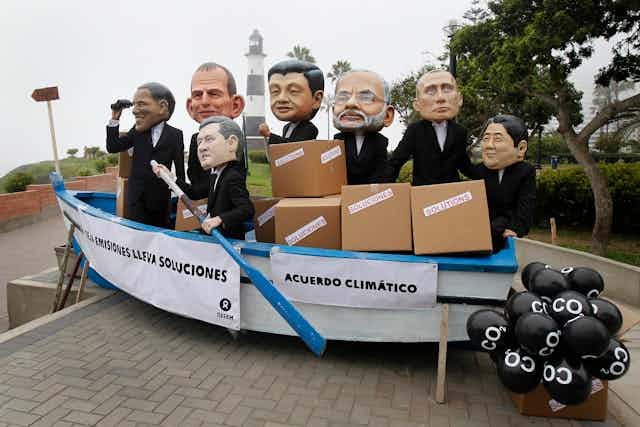Here’s a scene that will be familiar to anyone who has watched media coverage of a major geopolitical summit:
By mid-morning the main entrance to the UN’s Palais de Congres, and its side entrances, were ringed by Swiss and German citizens, chained together. The blockade was total, if symbolic. Diplomats came and went, but had to duck under the chains. A barrage balloon floated in the sky over the Palais, urging delegates to “Cut C0₂ Now”. Boiler-suited Greenpeace activists swarmed over the roofs of the Palais, clutching placards bearing the same message.
That was 25 years ago this weekend, outside the Second World Climate Conference in Geneva, as recounted (p.21) by British author and activist Jeremy Leggett. Leggett also noted the “uncharacteristic leniency” of the attendant riot police, which he claimed was down to the Swiss government’s wish “to be seen to be under citizen pressure” to help enact its proposed carbon tax.
What this episode shows – besides the wearying persistence of the same issues a quarter-century later – is that the climate protest movement predates what many people think of as the formal beginning of the United Nations climate process: the 1992 Rio Earth Summit.
Nor was it the first such protest. An estimated 10,000 people rallied outside the 1972 Stockholm Environment Conference, the UN’s first ever environmental summit – albeit over a wider range of issues and at a time when climate concerns were the preserve of only the most well-informed.
By the 1992 Rio summit, where one march attracted an estimated 50,000 people, the protest movement had swelled enough for police to dispense with the leniency of two years before. Security guards dragged 40 youth activists from Rio Centro and detained ten, and activists were forcibly ejected by police (p.259) after protesting that a Kenyan youth activist had her microphone cut midway through a speech to the meeting’s plenary.
COP this
It was another three years before the UN held the first of its annual “Conference of the Parties” (COP) meetings, of which the forthcoming gathering in Paris will be number 21. That meeting was held in Berlin, with the then German environment minister Angela Merkel in the chair.

At COP3 in Kyoto, Japan, in 1997 – the meeting that gave us the Kyoto Protocol – Japanese drummers drummed out pleas for action, although they couldn’t compete with Carbonosaurus, Greenpeace’s 7-metre dinosaur built from gasoline pumps, auto parts and old fuel tanks. Sightings of the beast continued for several years.
Three years later, in the Hague in 2000 – during the last COP of the innocent pre-September 11 days – activists were hanging from the rafters, storming the stage and berating diplomats for their sluggish progress.
By 2004, security everywhere had tightened, Carbonosaurus had retired, and Greenpeace instead sailed a “climate ark” in the streets outside COP10 in Buenos Aires.
Over the next few years, subsequent summits featured various photo opportunities, including a “wanted” posters for George W. Bush in Nairobi in 2006 and indigenous people from around the world gagging themselves outside COP13 in Bali in 2007.
Good COP, bad COP
And so to the “blockbuster” COP15, in Copenhagen in 2009, where hopes of a global successor to the Kyoto Protocol were running high. As well as thousands of delegates, the summit also attracted a huge protest contingent, with all of the media stunts and heavy security that previous COPs had led people to expect.
While the cabinet of the Maldives was holding an underwater meeting to demonstrate the country’s vulnerability to rising sea levels, the meeting’s Danish hosts were drafting new laws to give police sweeping powers of “pre-emptive arrest”, which they duly used as world leaders arrived.
Copenhagen began with an ice sculpture polar bear and ended with police foiling an attempted mass invasion of the conference centre. A year later a Danish judge ordered police to compensate activists for their heavy-handed tactics.

Since Copenhagen, protests at climate conferences have been muted. The 2012 “Rio 20+” Earth Summit passed off with colourful but peaceful protests and at Warsaw in 2013 Greenpeace beamed protests onto power station chimneys, while groups including Oxfam and WWF staged a walkout to protest the lack of ambition.
Deja vu?
Expectations of a global deal in Paris next month are again running high, with the French hosts anxious to avoid presiding over another flop, and delegates edging away from controversial policies such as carbon markets.
Outside the conference centre, activists are reportedly planning the largest ever civil disobedience campaign, and groups such as 350.org and Attac France are throwing their weight behind the “Climate Games” events.
The protests will involve 10 blockades, themed around “red lines” which they fear negotiators for the nearly 200 countries inside the summit may cross.
Expect media stunts (keep your eyes on the Eiffel Tower) and protests – not to mention highly collectable posters advertising the media stunts and protests. Expect the riot police to have a busy time.
If we’re lucky, the delegates will get their game faces on, and the protesters outside will return home enthused and able to hold their respective governments to the fine promises made, which are as old as that Geneva climate conference.

